Mount Edziza volcanic complex
The Mount Edziza volcanic complex (/ədˈzaɪzə/; abbreviated MEVC) is a linear group of volcanoes and associated lava flows in northwestern British Columbia, Canada. Located on the Tahltan Highland, it is 40 kilometres (25 miles) southeast of Telegraph Creek and 85 kilometres (53 miles) southwest of Dease Lake. The complex encompasses a broad, steep-sided lava plateau that extends over 1,000 square kilometres (390 square miles). Its highest summit is 2,786 metres (9,140 feet) above sea level, making the MEVC the highest of four large complexes in an extensive north–south trending volcanic region. An ice cap obscures the highest summit which is characterized by several outlet glaciers stretching out to lower altitudes.
| Mount Edziza volcanic complex | |
|---|---|
| Mount Edziza–Spectrum Range complex | |
 Mount Edziza with Eve Cone in the distant foreground | |
| Highest point | |
| Peak | Mount Edziza[1] |
| Elevation | 2,786 m (9,140 ft)[1] |
| Coordinates | 57°42′55″N 130°38′04″W[2] |
| Dimensions | |
| Length | 75 km (47 mi)[3] |
| Width | 20 km (12 mi)[3] |
| Area | 1,000 km2 (390 sq mi)[1] |
| Volume | 670 km3 (160 cu mi)[4] |
| Geography | |
 Mount Edziza volcanic complex Location in British Columbia | |
| Country | Canada[5] |
| Province | British Columbia[5] |
| District | Cassiar Land District[2] |
| Protected area | Mount Edziza Provincial Park[6] |
| Parent range | Tahltan Highland[7] |
| Topo map | NTS 104G15 Buckley Lake[8] NTS 104G10 Mount Edziza[2] NTS 104G7 Mess Lake[9] |
| Geology | |
| Formed by | Shield volcanoes, stratovolcanoes, subglacial volcanoes, lava domes, cinder cones, calderas[10] |
| Age of rock | Less than 12,000,000 years old[10] |
| Type of rock | Alkali basalt, hawaiite, trachyte, rhyolite, trachybasalt, tristanite, mugearite, benmoreite[11] |
| Volcanic region | Northern Cordilleran Province[4] |
| Last eruption | Unknown[12] |
The MEVC consists of several types of volcanoes, including stratovolcanoes, shield volcanoes, cinder cones, lava domes and calderas. These volcanoes have formed over the last 12 million years by successive eruptions of lava and pyroclastic rocks. The eruptions occurred during five magmatic cycles which were characterized by 13 periods of eruptive activity. More than 29 eruptions have occurred during the fifth magmatic cycle in the last 20,000 years, many of which remain undated. Most of these eruptions were characterized by fluid lava flows and lava fountaining but at least one explosive eruption deposited a small volume of pumice on the plateau. Current activity occurs exclusively in the form of hot springs. Future eruptions are likely to impact local streams and cause wildfires.
Several streams surround the MEVC, many of which drain the flanks of the volcanic complex. This includes the Little Iskut River along the southeastern flank, Kakiddi Creek along the northeastern flank, the Klastline River along the northern flank and Mess Creek along the western flank. The valleys of these streams contain several species of trees, including pine, aspen and spruce. A wide variety of animal species inhabit the area. This includes birds, rodents, bears, sheep, goats, moose and caribou. Warm summers and cold, snowy winters characterize the climate at the MEVC; snow and ice remain on the highest volcanoes year-round.
Indigenous peoples have lived adjacent to the MEVC for millennia. The local Tahltan people used volcanic glass from the MEVC to make tools and weaponry in prehistoric times. Intermittent geological work has been carried out at the volcanic complex since the 1950s, the most detailed studies having been conducted in the 1960s. Mineral exploration was carried out on the eastern flank of the MEVC periodically between 1957 and 1992. A large provincial park dominates the MEVC which can only be accessed by aircraft or by a network of trails.
Geography
Location
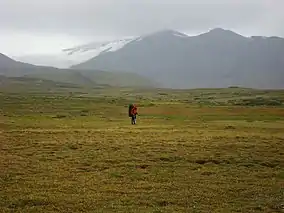
The MEVC is situated within the Boreal Mountains and Plateaus Ecoregion, a large ecological region in northwestern British Columbia encompassing high plateaus and rugged mountains with intervening lowlands. Boreal forests of black and white spruce occur in the lowlands and valley bottoms whereas birch, spruce and willow form forests on the mid-slopes. Extensive alpine altai fescue covers the upper slopes but barren rock is abundant at higher elevations. A cold, dry boreal mountain climate characterizes this ecoregion. The Boreal Mountains and Plateaus Ecoregion consists of seven ecosections. The Southern Boreal Plateau Ecosection is the main ecosection at the MEVC; it comprises several upland summits, as well as wide river valleys and deeply incised plateaus.[13]
The MEVC dominates the eastern edge of the Tahltan Highland. This is a southeast-trending upland area extending along the western side of the Stikine Plateau. It lies between the Taku River in the north, the Boundary Ranges in the west and the head of the Iskut River in the east. The width of the Tahltan Highland varies from about 8 kilometres (5.0 miles) in the north to about 48 kilometres (30 miles) in the south where the Stikine River crosses the highland.[14]
Lakes
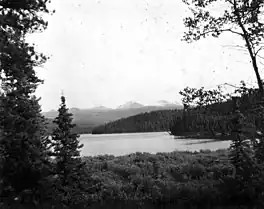
Several named lakes are present on and adjacent to the MEVC.[10] The eastern side of the MEVC is flanked by Kakiddi Lake, Mowchilla Lake, Mowdade Lake and Nuttlude Lake, all of which lie inside Kakiddi Valley.[6][10] With the exception of Mowdade Lake, all three lakes drain north into the Klastline River.[6] Buckley Lake is the main lake bordering the northern side of the MEVC while Mess Lake is the main lake bordering the western side of the MEVC. Southeast of the MEVC is 180 Lake, so-named because it is large enough for the Cessna 180 Skywagon to safely operate.[10] The southern end of the MEVC is flanked by Arctic Lake which gets its name from the surrounding barren and treeless landscape.[10][15]
Two small lakes are named on the southern portion of the MEVC.[16] At the head of the Little Iskut River is Little Ball Lake, also called Kounugu Lake after the guardian of fresh water in Tahltan folklore.[10][17] It lies immediately south of Kounugu Mountain in the Spectrum Range and east of Ball Creek.[16] Little Arctic Lake lies northeast of Arctic Lake near the northeastern flank of Wetalth Ridge.[18][19]
Drainage
The MEVC is drained on all sides by streams within the Stikine River watershed.[7][10] To the west, Mess Creek flows north along the Mess Creek Escarpment inside a broad valley paralleling the MEVC.[10] It then flows northwest into the Stikine River near the community of Telegraph Creek.[20] Several short tributaries of Mess Creek drain the western half of the MEVC where they have cut steep-sided canyons into the volcanic plateau.[10] This includes Crayke Creek which flows to the southwest,[7][21] Elwyn Creek which flows to the west,[7][22] Kitsu Creek which flows to the northwest,[23][24] Raspberry Creek which flows to the northwest,[7][25] Tadekho Creek which flows to the northwest[7][26] and Taweh Creek which flows to the northwest.[7][27] Many of these Mess Creek tributaries also contain tributaries. The only named tributary of Elwyn Creek is Kadeya Creek which flows northwest from Mount Edziza.[7] Kitsu Creek contains one named tributary, Nagha Creek, which flows northwest from the Spectrum Range.[7][28] Walkout Creek is the only named tributary of Raspberry Creek.[7] It flows west in a canyon west of the Armadillo Highlands and also contains only one named tributary, Flyin Creek, which flows northwest from near the west side of Cache Hill.[7][29][30] The only named tributary of Taweh Creek is Sezill Creek which flows northwest in a canyon southwest of Mount Edziza.[7][31]
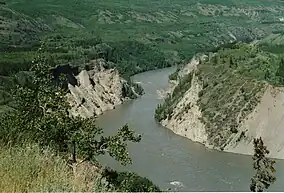
To the east, the MEVC overlooks a drainage divide that lies in a broad hummocky lowland. Its upper eastern half is drained by tributaries of Kakiddi Creek.[10] This includes Nido Creek, Tenchen Creek and Tennaya Creek which flow to the northeast from the eastern side of Mount Edziza,[7][32][33][34] Shaman Creek and Sorcery Creek which flow to the east and north from near Kaia Bluff[7][35][36] and Tsecha Creek which flows to the northeast from near Williams Cone.[7][37] Shaman Creek contains one named tributary, Chakima Creek, which flows to the east and north.[7][38] The rapidly eroding headwalls and steep spurs on the eastern side of the MEVC have deposited glacial and landslide debris into these tributaries. Transportion of this debris into Kakiddi Valley has produced several large alluvial fans behind which Kakiddi Lake, Mowchilla Lake, Mowdade Lake and Nuttlude Lake have formed.[10]
The lower eastern half and south end of the MEVC are drained by tributaries of the Iskut River.[7][10] This includes Ball Creek which flows to the south from the southeastern side of the Spectrum Range,[7][39] More Creek which flows to the southeast from the southern end of the Arctic Lake Plateau[7][40] and the Little Iskut River which flows to the southeast from the southeastern side of the Spectrum Range.[7][41] The only named tributary of Ball Creek is Chachani Creek which flows to the southeast from the eastern end of the Arctic Lake Plateau.[7][42] Tributaries of the Little Iskut River include Stewbomb Creek, which flows eastwards from the eastern side of the Spectrum Range, and Bourgeaux Creek which flows to the east from Raspberry Pass.[7][43][44] The only named tributary of Stewbomb Creek is Artifact Creek which flows to the southeast between Artifact Ridge and Obsidian Ridge.[7][45] Bourgeaux Creek contains one named tributary, Gerlib Creek, which flows southwards from between Tadeda Peak and Armadillo Peak.[7][46] Several small, unnamed streams drain the youthful northern side of the MEVC.[7][10] They flow north into the Klastline River and contain shallowly incised channels.[10]
Climate
The climate at the MEVC is characterized by warm summers and cold, snowy winters; Mount Edziza itself is covered by snow year-round. Temperatures are warmest in mid-summer during the day when they may hit the 30 degrees Celsius (86 degrees Fahrenheit) range. However, temperatures can drop below freezing during summer nights, making snow or freezing rain a possibility at any time of the year.[6] The closest weather stations to the MEVC are located at Telegraph Creek and Dease Lake, which lie about 40 kilometres (25 miles) to the northwest and 85 kilometres (53 miles) to the northeast, respectively.[47]
Meteorological data from the Telegraph Creek and Dease Lake weather stations suggest that the MEVC area has a temperature gradient of around −1.5 degrees Celsius (29.3 degrees Fahrenheit) per 1,000-metre (3,300-foot) increase in elevation. The data also suggest that precipitation likely increases with altitude. At Mess Creek, the mean annual temperature is probably around −1 degree Celsius (30 degrees Fahrenheit) while the annual precipitation likely amounts to 400 millimetres (16 inches) of snow and rain. The mean annual temperature at an elevation of 1,390 metres (4,560 feet) is likely about −1 to −5 degrees Celsius (30 to 23 degrees Fahrenheit) where annual precipitation amounts to approximately 400 to 500 millimetres (16 to 20 inches).[47]
Animals and plants
The MEVC is situated in an area with abundant wildlife. This wildlife includes moose, Osborn caribou, mountain goats, stone sheep, black bears, grizzly bears, wolves, Arctic ground squirrels and several species of birds. Arctic ground squirrels are abundant above the timberline where grizzly bears are occasionally seen. The alpine and subalpine zones between Mount Edziza and the western escarpment contain small herds of Osborn caribou. The western escarpment, the Spectrum Range and the eastern, western and southern flanks of Mount Edziza contain mountain goats and stone sheep. Birds such as scaup, owls, goldeneye, grebes, gyrfalcons, white-winged scoters, ravens, grouse and ptarmigans are present at the MEVC.[6]
The area between Buckley Lake and Telegraph Creek contains peat meadows, shrub fields and wet grasslands. It is characterized by long, severe winters with short growing seasons and deeply frozen soils. The Mess Creek, Kakiddi and Klastline valleys are intermixed with white spruce, trembling aspen and lodgepole pine, the latter two of which occur in drier areas. Balsam poplar grows on delta soils and near lakes and creeks. The MEVC plateau is characterized by alpine and sub-alpine vegetation zones.[6]
Glaciation

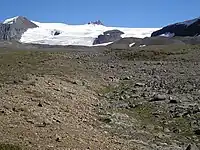
The MEVC has been extensively modified by local and regional glaciation as evidenced by the existence of drumlins and glacial striations, which record north-northwest ice movement across the western volcanic plateau. Evidence of ice stagnation is present in the form of outflow channels, eskers, kames, kettles and morainal ridges on the northern side of the MEVC adjacent to Buckley Lake. Deglaciation of unstable and oversteepened valley walls has caused several landslides, especially along the Mess Creek Escarpment. This instability is attributed to the low-yield strength of the highly fractured, poorly consolidated rocks comprising the MEVC.[10]
Most peaks greater than 2,130 metres (6,990 feet) in elevation contain glaciers. Small separate glaciers are largely restricted to the southern half of the MEVC where they occur in the Spectrum Range, on Armadillo Peak and elsewhere. In contrast, Mount Edziza and Ice Peak are obscured by a relatively large ice cap that covers an area of 70 square kilometres (27 square miles). The western side of this ice cap is drained by many outlet glaciers that spread in broad lobes onto the Big Raven Plateau. Distributary glaciers extending from the eastern side of the ice cap drape down steep slopes to form broken icefalls.[10]
Five named glaciers are situated at the northern and southern ends of the MEVC.[7] Idiji Glacier lies southeast of Mount Edziza on the eastern side of the MEVC.[7][48] At the head of Nagha Creek in the western portion of the Spectrum Range is Nagha Glacier.[7][49] Tenchen Glacier is a debris-covered glacier on the eastern side of Mount Edziza at the head of Tenchen Creek.[7][50] The debris covering Tenchen Glacier originates from landslides of the steep headwall and neighbouring spurs.[50] South of Mount Edziza lies Tencho Glacier, the largest glacier of the MEVC.[51] Tennaya Glacier lies at the head of Tennaya Creek on the southeastern side of Mount Edziza.[7][52]
Geology
Background
The MEVC is part of the Northern Cordilleran Volcanic Province (NCVP), a broad area of volcanoes extending from northwestern British Columbia northwards through Yukon into easternmost Alaska. Volcanism in this geologic province can be traced as far back as 20 million years ago with the emplacement of alkali basalt in western Yukon. Several types of volcanic eruptions have since created different landforms across the NCVP, including shield volcanoes, lava domes, stratovolcanoes and cinder cones. Other volcanic landforms, notably subglacial volcanoes, take their shape from the environment they formed in regardless of the type of magma they produced.[4] The NCVP contains more than 100 volcanoes and is the most volcanically active area in Canada; eruptions are expected to occur roughly every 100 years.[53]
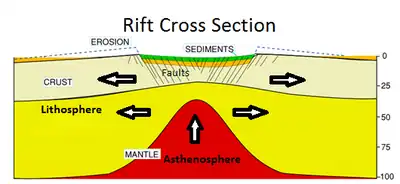
The MEVC is part of the Stikine Subprovince of the NCVP. This subprovince, confined to the Stikine region of northwestern British Columbia, includes three other volcanic complexes: Heart Peaks, Hoodoo Mountain and Level Mountain. All four complexes differ petrologically and/or volumetrically from the rest of the NCVP. Heart Peaks, Level Mountain and the MEVC are the largest NCVP centres by volume, the latter two having experienced volcanism for a much longer timespan than any other NCVP centre. Level Mountain, Hoodoo Mountain and the MEVC are the only NCVP centres that contain volcanic rocks of both mafic[lower-alpha 1] and intermediate to felsic[lower-alpha 2] composition.[55] The highest of the four complexes is the MEVC at 2,786 metres (9,140 feet), followed by Level Mountain at 2,164 metres (7,100 feet), Heart Peaks at 2,012 metres (6,601 feet) and Hoodoo Mountain at 1,850 metres (6,070 feet).[1][56][57][58]
Like other NCVP centres, the MEVC has its origins in rifting of the North American Plate caused by crustal extension.[4][59] This has resulted from the Pacific Plate sliding northward along the Queen Charlotte Fault, on its way to the Aleutian subduction zone in Alaska.[59] As the continental crust stretches, the near surface rocks fracture along steeply dipping faults parallel to the rift. Mafic magma rises along these fractures to create fluid lava flows, although more viscous felsic magma also makes its way to the surface and can produce explosive eruptions. Two major structural features, the Tintina and Denali–Coast fault systems, run parallel with the NCVP. Both structures have had strike-slip[lower-alpha 3] motions since the Cretaceous, which has resulted in several hundred kilometres of crustal displacement.[4]
Structure
The MEVC has a volume of 670 cubic kilometres (160 cubic miles) and an area of 1,000 square kilometres (390 square miles), making it the second largest eruptive centre in the NCVP after Level Mountain.[4] It comprises a broad, steep-sided, intermontane plateau that rises from a base elevation of 760 metres (2,500 feet).[1][47][61] Its sides tower 760 metres (2,500 feet) above adjacent valleys that serve as drainageways for several streams.[10][47] The edges of the plateau have been deeply incised by creeks that flow eastward and westward into Mess Creek, Kakiddi Creek and the Iskut River.[47] A northerly-trending, elliptical, composite shield volcano consisting of multiple flat-lying lava flows forms the plateau.[1] The MEVC has many geomorphological similarities to the Eyjafjallajökull volcano in Iceland. This includes its overall elongated structure, its flanking basaltic lava fields and its similar-sized summit ice cap dominated by silica-rich volcanic rocks.[62] The elongated structure of the MEVC is 75 kilometres (47 miles) long and 20 kilometres (12 miles) wide.[3] It is surrounded on the east by the Skeena Mountains and the Klastline Plateau while to the west it is flanked by the Coast Mountains.[10]
The MEVC lies on the eastern shoulder of Mess Creek valley. This is a long and narrow graben-like depression possibly linked to volcanism at the volcanic complex. The eastern edge of the valley is bounded by north-trending vertical faults, one of which has been traced for more than 24 kilometres (15 miles). This fault shows signs of having been active contemporaneously with volcanism at the MEVC. It has vertically displaced Holocene basalt flows of the MEVC by 15 to 20 metres (50 to 70 feet) and older MEVC basalt flows by 91 to 122 metres (299 to 400 feet), such that the western side of the fault has been downthrown. The downthrowing of this fault during the Holocene may have been due to the draining of magma chambers following eruptions at the MEVC.[63] The existence of peralkaline rocks[lower-alpha 4] at the MEVC and the presence of normal faults along the Mess Creek valley support the conclusion that the MEVC lies in an area of continental rifting.[63][65]
Subfeatures
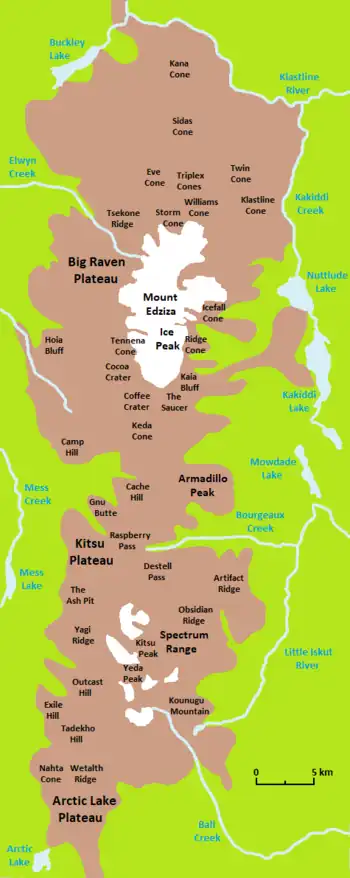
Four central volcanoes dominate the MEVC, each of which contains a caldera or the remnants thereof.[1][10] The highest, youngest and northernmost central volcano is Mount Edziza itself with an elevation of 2,786 metres (9,140 feet).[1] It is a large ice-covered stratovolcano rising well above the general level of the Tahltan Highland.[1][2][14] The southern flank of Mount Edziza overlaps with Ice Peak, the second oldest central volcano.[1] It is a composite stratovolcano that has been reduced to a steep-walled pyramidal peak with active cirques on all of its sides.[1][10] The southernmost and third oldest central volcano is the Spectrum Range.[1] It has a maximum elevation of 2,430 metres (7,970 feet) and consists of a nearly circular, more than 10-kilometre-wide (6.2-mile) dome with a thickness of up to 650 metres (2,130 feet).[1][10][12] Armadillo Peak between Ice Peak and the Spectrum Range is the oldest of the four MEVC central volcanoes. It represents the eroded remains of a small caldera whose 2,194-metre (7,198-foot) summit is capped by a 180-metre-thick (590-foot) sequence of ponded lava flows.[1] Various stages of erosion have modified these central volcanoes. In some cases, only a few small remnants of their original surface remain. The degree of erosion becomes less pronounced on those that have more recently formed.[10]
Numerous small cinder cones, which have reliefs of up to 460 metres (1,500 feet), dot the plateau surface.[10][47][61] They differ from the central volcanoes in that they are much smaller in size and most of the them have retained their original forms. A large percentage of these cones occur in three lava fields. The Desolation Lava Field on the northern slope of Mount Edziza contains 10 cinder cones, namely Eve Cone, Storm Cone, Moraine Cone, Williams Cone, Sleet Cone, Twin Cone, Sidas Cone and the Triplex Cones. Four named cones occur in the Snowshoe Lava Field on the southwestern flank of Ice Peak: Tennena Cone, Coffee Crater, Cocoa Crater and The Saucer. The Ash Pit is the only named cinder cone in the Mess Lake Lava Field which lies at the south-central end of the MEVC. Isolated cinder cones include Icefall Cone and Ridge Cone on the eastern slope of Mount Edziza, Nahta Cone at the extreme southern end of the MEVC and Kana Cone on the extreme northern flank of the MEVC.[10]
The MEVC contains three named subplateaus, the largest and northernmost of which is the Big Raven Plateau.[10] Its dominant feature is Mount Edziza which rises from within the middle of the plateau.[2] Two lava fields are present on the Big Raven Plateau. The Desolation Lava Field at the northern end of the plateau covers more than 150 square kilometres (58 square miles), making it the largest of the two lava fields. The smaller of the two lava fields is the Snowshoe Lava Field at the southern end of the Big Raven Plateau.[10] At the northwestern end of the Spectrum Range is the Kitsu Plateau.[10][66] Its dominant feature is the smaller Mess Lake Lava Field which covers around 18 square kilometres (6.9 square miles). The Arctic Lake Plateau is the southernmost of the three MEVC subplateaus. It consists of a nearly flat upland containing volcanic features such as Tadekho Hill, Wetalth Ridge, Nahta Cone, Source Hill, Thaw Hill and Exile Hill.[10]
The MEVC contains two named mountain passes.[10] Destell Pass is a narrow rock cleft northwest of Artifact Ridge that provides access between the broad upland valleys of Artifact Creek and Raspberry Creek.[10][67] Between the heads of Bourgeaux Creek and Raspberry Creek is Raspberry Pass, a broad east–west valley in the middle of the MEVC.[10][68] It separates the Spectrum Range in the south from the Mount Edziza area in the north.[6][10]
In the north fork of Tenchen Creek is Cinder Cliff, a 210-metre-high (690-foot) barrier of volcanic rocks.[10] Koosick Bluff and Ornostay Bluff are two bluffs just southwest of Mount Edziza near the head of Sezill Creek.[10][69][70] Northwest of Coffee Crater is Hoia Bluff, a prominent west-facing cliff.[71] Kaia Bluff is a steep-sided hill east of Coffee Crater.[72] On the northwestern side of Raspberry Pass is an isolated, flat-topped hill with steep sides called Gnu Butte.[73] The Mess Creek Escarpment is a long laterally continuous, often cliff-like feature forming the western edge of the MEVC. Much of this escarpment runs along the eastern side of Mess Creek where it exposes flat-lying lava flows.[10][74]
Petrology
A bimodal population of volcanic rocks characterizes the MEVC. The most voluminous rocks are mafic alkali basalts and hawaiites which comprise much of the plateau-forming shield volcano.[4] MEVC hawaiites are thought to have formed as a result of partial fractional crystallization and the accumulation of feldspar inside rising columns of mantle-derived alkali basalt.[11] Felsic peralkaline rocks such as comendite and trachyte are confined mainly to the four central volcanoes. They are the product of prolonged fractional crystallization of mantle-derived alkali basalt in magma chambers.[4] Volcanic rocks of intermediate composition are relatively small in volume and include tristanite, benmoreite, mugearite and trachybasalt.[11]
The MEVC is underlain by the Stikinia terrane.[4] This is a Paleozoic and Mesozoic suite of volcanic and sedimentary rocks that accreted to the continental margin of North America during the Jurassic.[4][10] Rocks of Paleozoic age underlie the western and southern portions of the MEVC. This includes limestone, bedded tuff and volcanic rocks of intermediate composition. Mesozoic rocks underlie most of the MEVC and include andesite, basaltic andesite, volcanic sandstone, siltstone, shale, greywacke, limestone and chert.[10] The volcanic and sedimentary rocks comprising Stikinia are remnants of a former island arc.[4]
Subdivisions
The MEVC is subdivided into the following geological formations, from youngest to oldest:[10]
| Sub-unit | Age | Lithology | Volume |
|---|---|---|---|
| Big Raven Formation | Holocene | Alkali basalt, hawaiite, trachyte | 1.7 cubic kilometres (0.41 cubic miles) |
| Kakiddi Formation | Pleistocene | Trachyte | 6.3 cubic kilometres (1.5 cubic miles) |
| Klastline Formation | Pleistocene | Alkali basalt | 5.4 cubic kilometres (1.3 cubic miles) |
| Arctic Lake Formation | Pleistocene | Alkali basalt | 2.0 cubic kilometres (0.48 cubic miles) |
| Edziza Formation | Pleistocene | Trachyte, comenditic trachyte | 18 cubic kilometres (4.3 cubic miles) |
| Pillow Ridge Formation | Pleistocene | Alkali basalt | 2.9 cubic kilometres (0.70 cubic miles) |
| Ice Peak Formation | Pleistocene | Alkali basalt, hawaiite, mugearite, benmoreite, trachyte | 76.7 cubic kilometres (18.4 cubic miles) |
| Pyramid Formation | Pleistocene | Trachyte, comendite, pantellerite | 11.4 cubic kilometres (2.7 cubic miles) |
| Spectrum Formation | Pliocene | Trachyte, comendite and pantelleritic trachyte, rhyolite | 118 cubic kilometres (28 cubic miles) |
| Nido Formation | Pliocene | Alkali basalt, hawaiite | 127 cubic kilometres (30 cubic miles) |
| Armadillo Formation | Miocene | Alkali basalt, comendite, trachyte | 159 cubic kilometres (38 cubic miles) |
| Little Iskut Formation | Miocene | Trachybasalt | 14.6 cubic kilometres (3.5 cubic miles) |
| Raspberry Formation | Miocene | Alkali basalt, hawaiite | 119 cubic kilometres (29 cubic miles) |
Eruptive history
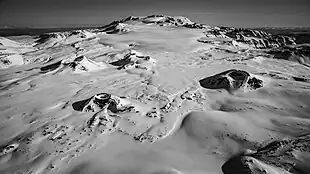
The MEVC is a highly active volcanic system with a nearly continuous record of activity dating from the Miocene.[75][76] It is the second most long-lived eruptive centre in the NCVP after Level Mountain, having started erupting in the last 12 milllion years.[4][10] Five cycles of magmatic activity formed the MEVC; one in the Miocene, one in the Pliocene, two in the Pleistocene and one in the Holocene. Each magmatic cycle began with the effusion of alkali basalt and culminated with the eruption of felsic magma. Very few rocks of intermediate composition were produced during these cycles, such that much of the MEVC is chemically bimodal.[10]
Eruptions have occurred subaqueously, subglacially and subaerially throughout the long eruptive history of the MEVC.[77] Subaqueous eruptions occur beneath the surface of water, resulting in explosions and the rapid cooling of lava.[10] Subglacial eruptions arise when volcanoes are obscured by glacial ice. They can cause rapid melting of glaciers, potentially creating volcano-induced glacial outburst floods known as jökulhlaups.[78] Subaerial eruptions take place in the open air rather than below water or ice.[79] They are capable of producing lava flows, lava fountains and ash flows. Most of the MEVC volcanic deposits are subaerial in origin.[10]
Interactions between ice and volcanism are well-documented at the MEVC. Out of the 13 geological formations comprising the MEVC, seven of them contain evidence of having been associated with ice. This includes the Pyramid, Ice Peak, Pillow Ridge, Edziza, Arctic Lake, Klastline and Big Raven formations which have all formed within the last two million years.[80] Volcano-ice interactions at these formations is represented by pillow lava, tuff breccia, hyaloclastite, glacial till interbedded with lava flows, and massive lava with well-developed slender columnar joints.[1][80] The MEVC has been scoured by regional glaciations at least twice throughout its eruptive history, as well as several lesser advances of local alpine glaciers.[1][10]
Potassium–argon dating of the MEVC has yielded ages ranging from 11.4 to 0.28 million years old. Most of these ages are consistent with the general volcanic stratigraphy, though some of them are anomalously old and most likely result from contamination of lava with pre-MEVC rocks of the Stikinia terrane.[10] Several geologically recent eruptions at the MEVC have not been quantitatively dated. Instead, a Holocene age is inferred because their eruptive products do not show evidence of having been glaciated by the Cordilleran Ice Sheet, which retreated from the area about 11,000 years ago. Therefore, many of these inferred Holocene eruptions may have occurred as early as the time of glacial retreat. An eruption recurrence interval of 379 years has been calculated for the MEVC by dividing 11,000 by the number of demonstrable Holocene eruptions. This would make the MEVC the most active eruptive centre in Canada throughout the Holocene.[75]
First magmatic cycle
The first magmatic cycle of the MEVC was restricted to the Late Miocene between 12 and 5.3 million years ago. Three eruptive periods occurred during this magmatic cycle, each producing different types of volcanic rocks. The first eruptive period is represented by alkali basalt and hawaiite flows of the Raspberry Formation. They rest directly on pre-MEVC rocks of the Stikinia terrane and are exposed along the Mess Creek Escarpment. The Little Iskut Formation represents the second period of eruptive activity. It conformably overlies the Raspberry Formation and consists mainly of trachybasalt flows. The third and final eruptive period of the first magmatic cycle is represented by alkali basalt, comendite and trachyte of the Armadillo Formation which conformably overlies the Little Iskut Formation.[10]
Raspberry eruptive period
The Raspberry eruptive period between 12 and 5.4 million years ago began with the effusion of basaltic lava flows from near Raspberry Pass. More than 83 cubic kilometres (20 cubic miles) of lava flows were extruded in rapid succession, forming a Late Miocene shield volcano. They reached a maximum thickness of more than 300 metres (980 feet) near their source to only a few metres thick at their terminus. Disruption of the local drainage system by lava flows during this eruptive period resulted in the formation of so-named Raspberry Lake in the upper Little Iskut River valley. The lava flows damming Raspberry Lake originated from a cluster of small satellitic cones south of the Raspberry shield volcano. By the time the Raspberry eruptive period had come to an end, the Raspberry shield volcano covered an area of at least 775 square kilometres (299 square miles) and reached an elevation of nearly 2,100 metres (6,900 feet).[10]
After the Raspberry eruptive period ceased, Raspberry Lake had already begun to erode a notch along the eastern edge of the lava dam. The Raspberry shield volcano and associated satellitic cones and ash beds had also begun to erode away, but the valleys and lowlands would remain filled with thick piles of basaltic lava flows. These lava flows would later be overlain by the much younger Mount Edziza and Spectrum Range.[10]
Potassium–argon dating of volcanic rocks produced during this eruptive period has yielded a wide variety of ages. This includes 11.4 ± 1.5 million years, 8.4 ± 0.4 million years and 6.4 ± 0.3 million years for Raspberry hawaiite and 6.1 ± 0.4 million years and 5.5 ± 0.1 million years for Raspberry alkali basalt.[10] The first date is anomalously old and has the largest error. A minimum age for the timing of Raspberry volcanism is 7.4–6.2 million years.[81]
Little Iskut eruptive period
The Little Iskut eruptive period 7.2 million years ago began beneath the waters of Raspberry Lake. Interactions between the lake water and the erupting magma resulted in several violent phreatic explosions, the larger explosions having deposited ash and granular particles over much of the lake floor. The phreatic explosions were followed by the eruption of trachybasalt flows which began forming a lava dome on the floor of Raspberry Lake. This lava dome eventually grew above lake level from continued volcanic eruptions to form a small volcanic island. Renewed volcanism then transformed this small island into a broad shield volcano that overlapped with the northern shoreline of Raspberry Lake. By this time much of the original lake had been displaced with ash and shattered rock fragments formed from the quenching of lava. Subsequent eruptions of the Little Iskut shield volcano produced lava flows that travelled down its gentle eastern, southern and western flanks. Lava flowing down the eastern and southern flanks entered the shrinking remnants of Raspberry Lake while lava travelling down the western flank merged with the older Raspberry shield volcano.[10]
Erosional remnants of trachybasalt flows from this eruptive period are exposed in a 10-kilometre-wide (6.2-mile) area northeast of the Spectrum Range. They range in thickness from about 300 metres (980 feet) near the centre of Artifact Ridge to 90 metres (300 feet) around the parameter, suggesting that their source was located near Artifact Ridge. This is supported by the existence of dikes[lower-alpha 5] along the northern side of Artifact Creek valley which may have been feeders for the overlying trachybasalt flows.[10]
A single potassium–argon date of 7.2 ± 0.3 million years has been obtained from Little Iskut trachybasalt.[10] The lack of an erosion surface between the Raspberry and Little Iskut formations suggests that the Little Iskut eruptions immediately followed or may have been coeval with eruptions of the Raspberry period.[83]
Armadillo eruptive period
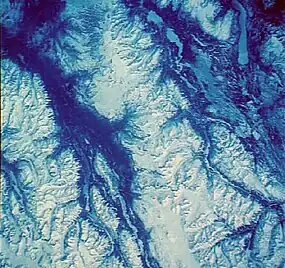
The next eruptive period, the Armadillo period, occurred between 7.0 and 6.0 million years ago.[1][10] It began with explosive activity from a vent at Cartoona Ridge which produced 10-kilometre-long (6.2-mile) ash flows and an air-fall pumice deposit that covers an area of several hundred square kilometres. This was followed by the effusion of viscous trachyte and rhyolite lava which piled up around the vent area to produce steep-sided, overlapping domes. As the lava domes continued to grow their slopes became oversteepened, forcing lava to move further away from the vent area. Eventually bulbous mounds of trachyte and rhyolite covered much of the southeastern highlands of the MEVC.[10]
Rapid evacuation of a shallow magma chamber nearly 8 kilometres (5.0 miles) south of Cartoona Ridge resulted in the formation of the 3-kilometre-wide (1.9-mile) Armadillo caldera. Fractures in the roof of the magma chamber provided passageways for trachyte magma to reach the subsiding caldera floor, resulting in the formation of lava lakes inside the newly-formed depression. Larger volumes of lava eventually spilled over the caldera rim to produce a nearly 13-kilometre-long (8.1-mile) sequence of trachyte and rhyolite flows. The sequence is up to 460 metres (1,510 feet) thick and extends to the west.[10]
A number of other volcanic centres were active during the Armadillo eruptive period. Tadeda Peak and the IGC Centre, both satellitic vents of the Armadillo caldera, produced trachyte and rhyolite. Alkali basalt flows issued from Sezill Volcano and the Little Iskut shield volcano, many of which are exposed along the Mess Creek Escarpment. The thickest sections of Armadillo basalt flows are exposed in Sezill Creek canyon and near the southwestern end of Raspberry Pass where they reach thicknesses of up to 180 metres (590 feet).[10]
An anomalously old potassium–argon date of 10.2 ± 1.4 million years has been obtained from Armadillo comendite. Potassium–argon dates more in line with the volcanic stratigraphy include 6.9 ± 0.3 million years and 6.1 ± 0.1 million years from comenditic ash flows, 6.9 ± 0.3 million years from comenditic glass and 6.5 ± 0.2 million years, 6.3 ± 0.5 million years, 6.2 ± 0.1 million years and 6.1 ± 0.2 million years from hawaiite.[10]
Second magmatic cycle
The second magmatic cycle took place between 6.0 and 1.0 million years ago during the Pliocene and Early Pleistocene. Like the first magmatic cycle, it is subdivided into three eruptive periods. The first eruptive period is represented by alkali basalt and hawaiite flows of the Nido Formation. They are exposed along the Mess Creek Escarpment and appear to have issued from several separate eruptive centres along the eastern margin of the MEVC. The Spectrum Formation represents the second period of eruptive activity. It is almost entirely underlain by the Nido Formation and consists mostly of trachyte and rhyolite. The third and final eruptive period of the second magmatic cycle is represented by trachyte, comendite and pantellerite of the Pyramid Formation which overlies the Nido Formation.[10]
Nido eruptive period
The Nido eruptive period was a long episode of volcanic activity that took place between 6.0 and 4.0 million years ago. It involved the effusion of highly mobile, fluid basaltic lava flows from multiple, widely spaced eruptive centres. These eruptive centres included at least six major volcanoes and many more smaller volcanic cones. The lava flows buried lag gravels and travelled into valleys where they disrupted the drainage system to form lava-dammed lakes. Volcanism of the Nido eruptive period was limited to the northern and southern ends of the MEVC, such that the lava flows formed two separate lava fields at each end of the volcanic complex. The northern lava field is represented by the Tenchen Member while the southern lava field is represented by the Kounugu Member. Both lava fields are separated by the Armadillo Highlands which acted as a topographic barrier at the time of their eruption. Volcanic activity in both lava fields occurred more or less simultaneously. Potassium–argon dating of Nido alkali basalt has given ages of 7.8 ± 0.3 million years, 5.5 ± 1.6 million years, 4.5 ± 0.3 million years and 4.4 ± 0.5 million years.[10] The first age comes from basalt of the Kounugu Member and, if correct, implies that Nido eruptions may have spanned from Raspberry to post-Armadillo time.[84]
Three major volcanoes of the Tenchen Member were active during the Nido eruptive period, all of which have since been reduced to eroded remnants. Alpha Peak was the oldest of the three major volcanoes. It issued lava flows from both satellitic and central vents which diverted and blocked local streams to form lava-dammed lakes. The second oldest major volcano, Beta Peak, formed 12 kilometres (7.5 miles) south of Alpha Peak. It rose at least 365 metres (1,198 feet) above the surrounding landscape and produced lava flows that travelled at least 13 kilometres (8.1 miles) to the north. Gamma Peak, the youngest of the three major volcanoes, formed south of Beta Peak on the western flanks of Cartoona Ridge. Lava flows from Gamma Peak buried gently sloping alluvial fans on the northern and western flanks of the Armadillo Highlands.[10] An eroded remnant of Gamma Peak forms a prominent spire just southeast of Coffee Crater called Cartoona Peak.[10][85]
The Kounugu Member also contains the eroded remains of three major volcanoes that were active during Nido time. Swarm Peak, the oldest of the three major volcanoes, issued lava flows that travelled down the western and southern flanks of the Little Iskut shield volcano. Vanished Peak further to the south was formed during a major eruption that involved lava fountaining. Most of the lava from this eruption flowed to the north and west. Lost Peak is the youngest of the three major volcanoes. In contrast to the other two volcanoes, Lost Peak consists of volcanic rocks that were deposited in both subaerial and subaqueous environments. The subaqueous material was deposited in a lake that may have ponded between the erupting volcano and a lobe of glacial ice. Exile Hill was also active during Nido time and is a part of the Kounugu Member.[10]
Spectrum eruptive period
The next eruptive period, the Spectrum period, occurred between 4.0 and 2.0 million years ago. A relatively small initial eruption of pumice and ash was followed by the effusion of massive rhyolite flows, each up to 150 metres (490 feet) thick and 13 kilometres (8.1 miles) long. These rhyolite flows accumulated in rapid succession to form the broad Spectrum Range dome which reached a thickness of at least 750 metres (2,460 feet) and a width of more than 20 kilometres (12 miles). The predominantly rhyolitic eruptions were later replaced by the effusion of trachyte lava as deeper parts of the underlying magma chamber were tapped.[10] Formation of the Spectrum Range dome was followed by evacuation of the magma chamber, resulting in the creation of a 4.5-kilometre-wide (2.8-mile) summit caldera.[1][10] This caldera was eventually buried by lava from subsequent eruptions.[10]

Yeda Peak was the site of an explosive eruption near the end of the Spectrum period. This eruption resulted in the formation of a crater near the crest of the Spectrum Range dome. Some of the ejecta accumulated around the vent to form a low volcanic cone while the more volatile, pumice-rich phases of the eruption sent ash flows down the slopes of the dome. Renewed volcanism at Exile Hill 8 kilometres (5.0 miles) west of the Yeda Peak vent produced a similar but much smaller eruption. Late-stage volcanism of the Spectrum eruptive period produced alkali basalt flows of the Kitsu Member. These flows likely issued from several eruptive centres that have since been destroyed by erosion.[10]
The once continuous Spectrum Range dome was substantially eroded to form the current peaks and ridges of the Spectrum Range. Extensive erosion also reduced the size of the dome, leaving behind a few remnants around its northern and southwestern edges. Relatively thin trachyte flows northwest of the Spectrum Range on the Kitsu Plateau are the most distal remnants, although they may have originated from a nearby satellitic vent. Erosional remnants of Kitsu Member alkali basalt flows cap the higher summits of the Spectrum Range where they overlie the unmodified upper surface of the original dome. The original dome was much higher in elevation as evidenced by the thick, gently dipping trachyte flows forming the summit of Kitsu Peak.[10]
An anomalously old potassium–argon date of 5.9 ± 1.1 million years has been obtained from Kitsu Member alkali basalt. Potassium–argon dates more in line with the volcanic stratigraphy include 3.1 ± 0.1 million years and 3.0 ± 0.1 million years from comendite and 3.4 ± 0.1 million years and 2.9 ± 0.1 million years from comenditic glass.[10]
Pyramid eruptive period
The Pyramid eruptive period took place 1.1 million years ago.[10][80] It involved violent explosive eruptions of rock fragments, gas and trachyte pumice from a vent adjacent to the northwestern margin of the MEVC. This explosivity was accompanied by phreatic explosions and pyroclastic surges. Subsequent eruptions sent thin basalt flows into the valley of a north-flowing glacial stream where they formed a small lava-dammed lake.[10] This short period of basaltic volcanism was followed by the extrusion of felsic flows and domes forming The Pyramid.[10][80]
Renewed volcanism during this eruptive period produced the Sphinx Dome which may have formed subglacially.[10][80] Growth of the Sphinx Dome involved the eruption of viscous rhyolite and volcanic ejecta. Some of the ejecta settled in a lake that had formed between the growing dome and an ice field along its southern margin, resulting in the formation of an evenly distributed volcaniclastic[lower-alpha 6] deposit on the lake bed. The Sphinx Dome reached a height of 800 metres (2,600 feet) and a length of 5 kilometres (3.1 miles) by the time activity ceased.[10]
A third pulse of volcanism constructed the Pharaoh Dome just south of the lake that ponded during Sphinx Dome activity.[10] Eruptions were at first subglacial which led to a series of phreatic steam explosions and the quenching of rhyolite lava by meltwater. Pharaoh Dome eventually built above the level of the surrounding ice as flows of rhyolite continued to enlarge the dome.[10][80] By the time activity ceased, Pharaoh Dome had risen above the surface of a large ice field as a nunatak; it was subsequently buried under glacial ice.[10]
Potassium–argon dating of comenditic glass produced during the Pyramid eruptive period has yielded ages of 1.2 ± 0.4 million years and 1.20 ± 0.03 million years. Trachyte produced during this eruptive period has yielded potassium–argon dates of 0.94 ± 0.12 million years and 0.94 ± 0.05 million years.[10]
Third magmatic cycle
The third magmatic cycle occurred about one million years ago during the Early Pleistocene.[10] It was characterized by three eruptive periods, each represented by a geological formation.[10][80] The first eruptive period created the Ice Peak Formation which overlies the Nido and Pyramid formations. A wide variety of volcanic rocks comprise the Ice Peak Formation, including alkali basalt, hawaiite, trachybasalt, tristanite, mugearite, benmoreite and trachyte. The second eruptive period resulted in the creation of the Pillow Ridge Formation which consists mainly of alkali basalt.[10] This geological formation is confined to Pillow Ridge and Tsekone Ridge at the northern end of the MEVC.[10][80] The third and final eruptive period of the third magmatic cycle produced the Edziza Formation which overlies the Pyramid and Ice Peak formations. Trachyte is the main volcanic rock comprising the Edziza Formation.[10]
Ice Peak eruptive period
The Ice Peak eruptive period began at a time when the MEVC was covered by a receding regional ice sheet. Volcanism initially began on the southern flank of Sphinx Dome where pyroclastic material mixed with meltwater from residual ice to produce highly mobile debris flows and lahars. Lava flows advanced across the glaciated surface as successive eruptions built Ice Peak, resulting in the formation of narrow meltwater lakes. These lakes were displaced as the lava flows continued to advance down slope. Basaltic lava travelled further down slope onto the MEVC plateau while more viscous trachybasalt, tristanite, mugearite, benmoreite and trachyte lava accumulated around the vent area to form the steep, upper part of Ice Peak. At its climax, Ice Peak was a symmetrical stratovolcano containing a small crater at its summit; its symmetrical structure was later destroyed by glacial erosion. Potassium–argon dating of massive trachyte flows in the upper part of Ice Peak has yielded ages of 1.5 ± 0.4 million years, 1.5 ± 0.1 million years and 1.2 ± 0.1 million years.[10]
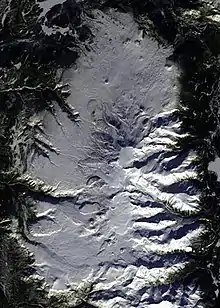
Two unusually thick lobes of trachyte lava issued from satellitic domes on the western flank of Ice Peak during this eruptive period, both of which were deposited onto the MEVC plateau. The southern lobe, Koosick Bluff, ranges in elevation from 1,890 to 2,010 metres (6,200 to 6,590 feet). It is bounded by cliffs that rise 60–90 metres (200–300 feet) to a nearly flat surface. With a length of nearly 2 kilometres (1.2 miles) and a width of more than 1 kilometre (0.62 miles), Koosick Bluff is the largest of the two lava lobes. The northern and smaller lobe, Ornostay Bluff, has a potassium–argon date of 1.5 ± 0.4 million years and is similar in composition and structure to Koosick Bluff.[10] The steep sides and unusually large thicknesses of these two lava lobes is attributed to them having been extruded through glacial ice.[80]
Volcanic activity during Ice Peak time created two volcanoes west of the Armadillo Highlands. The northern volcano, Camp Hill, began forming when the MEVC was still partially covered by glacial ice. Eruptions under the glacial ice formed a circular meltwater pond which quenched the erupting lava and caused phreatic explosions. The resulting fractured and churned debris accumulated around the erupting vent to create a broad tuff ring. This feature eventually grew above the level of the meltwater pond to produce subaerial lava fountains which formed a relatively steep-sided pyroclastic cone on top of the tuff ring. By this time the surrounding glacial ice had retreated, allowing basalt flows to spread over the Big Raven Plateau. The southern volcano, Cache Hill, formed during a period of eruptions on the western side of the Armadillo Highlands. Basalt flows blocked a northwesterly flowing river in a broad valley to form a small lava-dammed lake. Subsequent basalt flows travelled to the southeast and northwest, the southeasterly flows having entered the lava-dammed lake to create pillow lava.[10]
A circular volcanic plug called The Neck formed on the eastern side of the MEVC during the Ice Peak eruptive period. It consists of an older outer ring of fine grained trachyte and a younger inner core of coarse grained trachyte, suggesting that The Neck was the source of more than one trachyte eruption. This roughly 215-metre (705-foot) in diameter volcanic conduit has a potassium–argon date of 1.6 ± 0.2 million years.[10]
Pillow Ridge eruptive period
The next eruptive period, the Pillow Ridge period, occurred when the MEVC was still overlain by an ice sheet.[10][80] Subglacial volcanism injected basaltic lava into the base of the ice sheet where the molten basalt was quenched and then shattered by phreatic explosions. Accumulation of this fragmented debris around the erupting vent created a subglacial pile of tuff, breccia and pillow lava inside a meltwater cavity. The overlying ice sheet sagged as the volcanic pile and enclosing meltwater cavity grew larger, resulting in the formation of a meltwater lake inside a depression on the surface of the ice sheet. This meltwater lake was churned by phreatic explosions and probably reached a length of more than 4 kilometres (2.5 miles). Successive eruptions eventually built the volcanic pile above lake level to form a small temporary island that issued subaerial lava flows and lava fountains. The volcanic pile that formed as a result of this activity comprises Pillow Ridge. Fission track dating of Pillow Ridge alkali basalt has yielded ages of 0.9 ± 0.3 million years and 0.8 ± 0.25 million years.[10]
Another pulse of subglacial volcanism during the Pillow Ridge period created nearby Tsekone Ridge. Although it formed in a similar environment to that of Pillow Ridge, there is no evidence the Tsekone Ridge eruption was large enough to penetrate the overlying ice sheet. The basaltic magma that issued during this eruption may have been leftover from the series of eruptions that formed Pillow Ridge.[10]
Edziza eruptive period
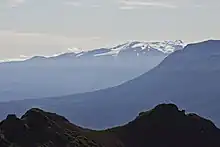
The Edziza eruptive period constructed the symmetrical stratovolcano of Mount Edziza after the regional ice sheet had retreated from the MEVC.[10][80] Growth began on the upper northern flank of Ice Peak with the eruption of viscous trachyte flows and steep-sided lava domes. The lava domes were punctuated by vent-clearing explosions which ejected volcanic blocks and lava bombs onto the slopes of the growing stratovolcano.[10] Formation of the stratovolcano was followed by collapse of the original summit, creating the 2-kilometre (1.2-mile) in diameter caldera that truncates it.[1][10] The cause of this collapse may have been a violent, climactic eruption that deposited parts of the original summit onto the flanks of the volcano. Prior to collapse, the summit of Mount Edziza was at least 610 metres (2,000 feet) higher than it is today.[10]
Most of the volcanic activity during this eruptive period was concentrated in the summit area of Mount Edziza but at least a few vents were active near the base of the volcano. Volcanism on the southeastern rim of the summit caldera created Nanook Dome. Lava from this dome flowed onto the outer surface of the stratovolcano and into the summit caldera to form lava lakes. Triangle Dome and Glacier Dome formed on the western and northeastern flanks of Mount Edziza, respectively. A trachyte flow from the latter dome travelled onto the gently sloping surface of the Big Raven Plateau. Lava from a small pyroclastic cone on the northwestern flank of Mount Edziza nearly engulfed both Pillow Ridge and Tsekone Ridge on the surrounding plateau. Pantelleritic trachyte produced during the Edziza eruptive period has given a potassium–argon date of 0.9 ± 0.3 million years.[10]
Fourth magmatic cycle
The fourth magmatic cycle took place between 0.8 and 0.2 million years ago during the Pleistocene. Like the previous three magmatic cycles, it was characterized by three eruptive periods.[10][80] The first eruptive period created the Arctic Lake Formation which underlies much of the Arctic Lake Plateau. Alkali basalt flows and related pyroclastic rocks comprise the Arctic Lake Formation. The second eruptive period is represented by the Klastline Formation along the Kakiddi and Klastline valleys. Thick alkali basalt flows are the main features of the Klastline Formation. The third eruptive period produced thick trachyte flows and pyroclastic rocks of the Kakiddi Formation which occupy valleys on the eastern flank of Ice Peak.[10]
Arctic Lake eruptive period
The Arctic Lake eruptive period occurred 0.7 million years ago on the Arctic Lake Plateau. At least seven volcanoes formed during this period, each of which issued basaltic lava.[10][80] Lava fountaining at the extreme northern end of the Arctic Lake Plateau created Outcast Hill which blocked westerly flowing streams. The damming of these streams resulted in the formation of a temporary lake against the eastern side of Outcast Hill. Lava from this volcano flowed into the lake but most of it travelled westward towards the Mess Creek Escarpment. Tadekho Hill 4 kilometres (2.5 miles) to the south formed on top of a 180-metre-high (590-foot) remnant of Spectrum trachyte. Lava from Tadekho Hill spread onto the surrounding plateau surface to form a small shield volcano. Outcast Hill and Tadekho Hill both formed when the Arctic Lake Plateau was relatively free of glacial ice.[10]
The Arctic Lake Plateau was subsequently covered with ice as glaciers advanced from the neighbouring Spectrum Range. Subglacial volcanism at the height of this glacial advance created Wetalth Ridge near the middle of the plateau. This was followed by the eruption of four other volcanoes on the Arctic Lake Plateau during the waning stages of glaciation. Two small mounds of quenched pillow lava informally called Knob 1 and Knob 2 formed subglacially south of Wetalth Ridge. The third volcano, Source Hill, was created during a massive lava eruption when only the central part of the Arctic Lake Plateau contained a thin lobe of glacial ice. Late-stage volcanism of the Arctic Lake eruptive period formed Thaw Hill on the eastern side of the Arctic Lake Plateau. Alkali basalt from this eruptive period has yielded a potassium–argon date of 0.71 ± 0.05 million years.[10]
Klastline eruptive period
The Klastline eruptive period 0.6 million years ago was characterized by minor lava fountaining and the effusion of massive basalt flows from vents along the northern flank of Mount Edziza.[10][80] The basalt flows travelled adjacent to Buckley Lake and into the Klastline and Kakiddi valleys, the most extensive ones having reached 25 kilometres (16 miles) long. Pyroclastic cones developed on the lower slopes of the MEVC where eruptions were subaerial. Explosive interaction between lava and meltwater from an alpine glacier formed the Klastline tuff cone higher up on the plateau. Lava from Klastline Cone entered Kakiddi Valley where it blocked the flow of Kakiddi Creek. This lava then flowed north across dry gravel bars to the confluence with Klastline Valley, temporarily damming the Klastline River to form a large shallow lake. Most of the lava continued to flow westward through Klastline Valley for at least another 19 kilometres (12 miles). Potassium–argon dating of Klastline alkali basalt has yielded an age of 0.62 ± 0.04 million years.[10]
Kakiddi eruptive period
The Kakiddi eruptive period 0.3 million years ago involved the eruption of a massive trachyte flow that reaches almost 1 kilometre (0.62 miles) wide and 60–90 metres (200–300 feet) thick.[10][80] It advanced 7 kilometres (4.3 miles) down the eastern flank of the MEVC into Kakiddi Valley where it spread out into a more than 20-square-kilometre (7.7-square-mile) terminal lobe. The source of this lava flow remains unknown but it may have issued from Ice Peak and possibly Nanook Dome at the summit of Mount Edziza. A relatively small lava flow issued from a vent on the western flank of Ice Peak and advanced onto the Big Raven Plateau. Potassium–argon dating has yielded an age of 0.31 ± 0.07 million years for Kakiddi mugearite and 0.30 ± 0.02 million years for Kakiddi trachyte.[10]
Fifth magmatic cycle

The fifth magmatic cycle, which may still be ongoing, commenced in the last 20,000 years with the onset of the Big Raven eruptive period.[10][80] It was marked by the eruption of subglacial volcanoes, cinder cones and lava flows along the entire length of the MEVC, as well as a single eruption of pumice from the southwestern flank of Ice Peak. Most of the Big Raven eruptions took place on the western flank of Ice Peak and on the northern flank of Mount Edziza where lava flows from several vents accumulated to form the Desolation and Snowshoe lava fields.[10]
The rocks produced during the Big Raven eruptive period comprise the Big Raven Formation. They are mainly alkali basalts and hawaittes, although a small volume of comenditic trachyte was also produced.[10] More than 29 eruptions took place during this eruptive period, most of which resulted in the creation of cinder cones.[10][75] These cones are of Holocene age and occur in the Snowshoe Lava Field, the Desolation Lava Field and adjacent to the Spectrum Range.[86] Eruptions during Big Raven time continued within the last 2,000 years, but the precise age of the latest one is unknown.[12][86]
Snowshoe Lava Field
One of the first volcanoes to erupt during the Big Raven eruptive period was Tennena Cone which formed high on the western flank of Ice Peak.[10] It issued basaltic magma under the summit ice cap during the height of the neoglaciation when the ice cap was much larger in area than it is now.[10][80] As the molten basalt accumulated around the erupting vent, it was quenched by the overlying ice cap to form the steep-sided, pyramid-shaped pile of pillow lava that comprises Tennena Cone. A meltwater channel thawed from the base of the cone provided the pathway for a thin lava flow. As the lava flow reached the western edge of the ice cap, it caused a violent interaction with meltwater which spread onto the plateau. Two unnamed volcanoes also in the Snowshoe Lava Field formed subglacially south of Tennena Cone.[10]
After the summit ice cap retreated from lower elevations, renewed volcanism in the Snowshoe Lava Field constructed Cocoa Crater, Coffee Crater and other subaerial cinder cones by lava fountaining. Their construction was accompanied by the eruption of massive lava flows that travelled into the valleys of Sezill Creek and Taweh Creek. Lava from a fissure eruption south of Tencho Glacier flowed west into Taweh Creek and east into Shaman Creek. The result of this eruption was the formation of The Saucer which is one of the youngest volcanic features in the Snowshoe Lava Field.[10]
Arctic Lake Plateau and east slope centres
.JPG.webp)
Two Big Raven centres occur at the southern end of the MEVC. Nahta Cone is the southernmost and lies near the northern edge of the Arctic Lake Plateau. It was the source of a narrow, 3-kilometre-long (1.9-mile) basaltic lava flow that travelled northwards and then westwards into the head of Nahta Creek. The other eruptive centre is a now-destroyed cinder cone that formed on the unstable southern flank of Kuno Peak in the Spectrum Range. It produced a basaltic lava flow that travelled onto the Arctic Lake Plateau. Subsequent landsliding on Kuno Peak removed much of the original cone and buried the associated lava flow.[10]
At least three eruptive centres were active on the deeply eroded eastern flank of Mount Edziza during the Big Raven eruptive period. Cinder Cliff in the north fork of Tenchen Creek valley formed when an eruption of basaltic lava engulfed loose debris and ponded against stagnant ice. The other two eruptive centres, Icefall Cone and Ridge Cone, have been glaciated and are poorly exposed. Both cones produced lava flows but they are also poorly exposed, having been almost completely buried under gravel, moraine, talus and glacial ice. A 6.5-kilometre-long (4.0-mile) lava flow occupying a narrow, wedge-shaped valley on the east slope of Mount Edziza may have issued from Icefall Cone, Ridge Cone or an undiscovered vent inside the valley. Its terminus lies near Kakiddi Lake where it is well exposed for 2 kilometres (1.2 miles).[10]
Desolation and Mess Lake lava fields
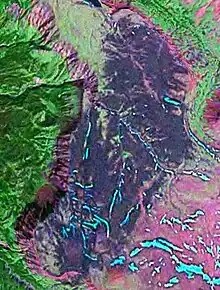
The first cones to form in the Desolation Lava Field were Sleet Cone and Storm Cone, both of which produced lava flows that travelled over glacial till. Subsequent volcanism created the three Triplex Cones 3 kilometres (1.9 miles) north of Storm Cone. They issued a 12-kilometre-long (7.5-mile) sequence of lava flows that extends northwesterly to near the south shore of Buckley Lake. Renewed eruptive activity formed Sidas Cone and Twin Cone, both of which are products of simultaneous lava fountaining from more than one vent. Lava flows from both cones travelled to the northwest and northeast, respectively. The subsequent eruption of Moraine Cone produced a roughly 14-kilometre-long (8.7-mile) lava flow that travelled northeast into the Kakiddi Creek and Klastline River valleys; both streams were temporarily dammed by the lava flow. Eve Cone and Williams Cone were created by the latest eruptions in the Desolation Lava Field, both of which produced lava flows more than 10 kilometres (6.2 miles) long.[10] Willow twigs preserved in ejecta from Williams Cone have yielded a radiocarbon date of 610 CE ± 150 years.[10][87]
The Mess Lake Lava Field northwest of the Spectrum Range issued from three cinder cones on the edge of the Mess Creek Escarpment.[10][12] Lava flows from the two oldest cones travelled to the west and most likely cascaded down the escarpment into Mess Creek valley. However, any remnants of this lava on the escarpment or in Mess Creek valley have been removed by erosion. The youngest cinder cone, The Ash Pit, formed at the south end of the Mess Lake Lava Field. Eruptions from The Ash Pit produced mainly pyroclastic ejecta in the form of ash and cinders. Much of this material was blown to the northeast by a strong, uniform wind during eruption and deposited onto the Kitsu Plateau.[10]
Kana Cone and Walkout Creek centres
The Kana Cone eruption was characterized by the effusion of basaltic lava flows and the build up of volcanic ejecta around the erupting vent. Several lobes of lava were produced during this eruption. They flowed around eroded remnants of lava produced during the Klastline eruptive period and engulfed the Klastline River valley, temporarily damming the river. The Klastline River was forced to establish a new route along the northern valley wall where it still flows to this day. Several pulses of lava took place during the Kana Cone eruption, each resulting in the formation of new lava channels.[10]
Two small cinder cones formed in Walkout Creek valley during the Big Raven eruptive period, both of which produced basaltic lava flows. The largest cone is about 120 metres (390 feet) high and was constructed on top of a slow moving landslide originating from the northern side of the valley. Both cones have been deeply dissected, the larger cone having been segmented into arcuate, step-like slices from continued movement of the landslide.[10]
Sheep Track Member
A small but violent VEI-3 eruption burst from the southwestern flank of Ice Peak near the end of the Big Raven eruptive period.[10][87] It deposited the Sheep Track Member which consists of volcanic ejecta that fell over an area of about 40 square kilometres (15 square miles). The ejecta consists of granular trachyte pumice that varies from snowball-sized chunks near the vent area to pea-sized fragments around the parameter of the deposit. All of the Snowshoe Lava Field flows and cones are covered by Sheep Track pumice with the exception of The Saucer which likely postdates the Sheep Track eruption.[10] The location of the vent that produced the Sheep Track Member is unknown but it may lie under the Tencho Glacier.[10][80] Fission track dating has yielded an age of 950 CE ± 6,000 years for the Sheep Track Member.[87]
Present day status
The MEVC is volcanically dormant but it still remains hydrothermally active.[10][88] Four hot spring areas are found along the western flank of the MEVC at Mess Lake, Mess Creek, Elwyn Creek and Sezill Creek, the latter three of which have recorded water temperatures of 42.5 degrees Celsius (108.5 degrees Fahrenheit), 36 degrees Celsius (97 degrees Fahrenheit) and 46 degrees Celsius (115 degrees Fahrenheit), respectively.[10][89] Discharge at the Sezill Creek, Elwyn Creek and Mess Lake hot springs may be linked to shallow hydrothermal systems driven by residual magmatic heat as they are adjacent to recently active eruptive centres. In contrast, the Mess Creek Hot Springs may be discharging from a deeply circulating hydraulic system along a major fault on the western side of Mess Creek valley.[10] Estimated subsurface temperatures, as derived from geothermometers, are 177 degrees Celsius (351 degrees Fahrenheit) based on silica concentrations and 227 degrees Celsius (441 degrees Fahrenheit) based on sodium-potassium-calcium ratios.[90] This makes the MEVC a potential high-temperature geothermal resource area but it does not warrant subsurface exploration due to its remote location.[90][91]
The Mess Lake Hot Springs are situated near the southeastern corner of Mess Lake.[10] They had a vigorous flow of warm water in 1965 but are now inactive, having dried up by 1983.[89][10] These springs lie at an elevation of 760 metres (2,490 feet) and have created massive deposits of tufa that cover more than 120 hectares (300 acres).[10][92] About 7 kilometres (4.3 miles) south of Mess Lake are the Mess Creek Hot Springs.[10] They are located on the western side of Mess Creek where they attain an elevation of 760 metres (2,490 feet).[10][92] The Elwyn Hot Springs occur along the banks of Elwyn Creek at an elevation of 1,440 metres (4,720 feet) where they have created thick tufa deposits.[10][93] Extending 0.5 kilometres (0.31 miles) along Sezill Creek are the Taweh Hot Springs which contain extensive tufa.[10] They occur at an elevation of 1,310 metres (4,300 feet) and emit thermal waters containing carbon dioxide.[10][93]
Hazards and monitoring
Natural Resources Canada considers the MEVC a high threat volcanic complex as it has the highest eruption rate in Canada. However, its extremely remote location makes it less hazardous than volcanoes in southwestern British Columbia.[75] MEVC trachyte and rhyolite contain silica-rich compositions that are comparable to those associated with the most powerful eruptions around the world. Parts of northwestern Canada would be affected by an ash column if an explosive eruption were to happen at the MEVC.[89] Ash columns can drift for thousands of kilometres downwind and often become increasingly spread out over a larger area with increasing distance from an erupting vent.[94] An eruption under the summit ice cap would possibly produce floods or lahars that could travel into the Stikine or Iskut rivers.[62] Lava flows are also a potential hazard as they have formerly dammed the Klastline and Stikine rivers, the latter of which contains a major salmon fishery.[88][89] Another potential hazard at the MEVC is the ignition of wildfires by eruptions as the area contains vegetation.[6][89]
Like other volcanic complexes in Canada, the MEVC is not monitored closely enough by the Geological Survey of Canada to ascertain its activity level. The Canadian National Seismograph Network has been established to monitor earthquakes throughout Canada, but it is too far away to provide an accurate indication of activity under the complex. It may sense an increase in seismic activity if the MEVC becomes highly restless, but this may only provide a warning for a large eruption; the system might detect activity only once the complex has started erupting.[95] If the MEVC were to erupt, mechanisms exist to orchestrate relief efforts. The Interagency Volcanic Event Notification Plan was created to outline the notification procedure of some of the main agencies that would respond to an erupting volcano in Canada, an eruption close to the Canada–United States border or any eruption that would affect Canada.[96]
Human history
Indigenous peoples
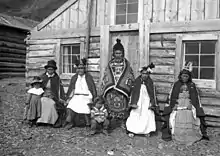
The MEVC lies within the traditional territory of the Tahltan people which covers an area of more than 93,500 square kilometres (36,100 square miles).[97] In prehistoric times, the MEVC was a significant source of obsidian for the Tahltan people. It was used in the manufacturing of projectile points and cutting blades which were widely traded throughout the Pacific Northwest.[6] Obsidian from the MEVC has been recovered from archaeological sites in Alaska, Yukon, western Alberta and along the British Columbia Coast, making Edziza obsidian the most widely distributed obsidian in western North America. Edziza obsidian from the Hidden Falls archaeological site in Alaska has a date of 10,000 years. This suggests that the MEVC was being exploited as an obsidian source soon after ice sheets of the last glacial period retreated.[98]
The MEVC continues to be an important cultural resource for the Tahltan people. In 2021, Chad Norman Day, president of the Tahltan Central Government, said "Mount Edziza and the surrounding area has always been sacred to the Tahltan Nation. The obsidian from this portion of our territory provided us with weaponry, tools and trading goods that ensured our Tahltan people could thrive for thousands of years."[99]
Telegraphy
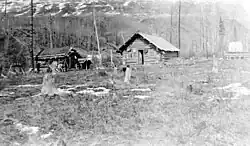
Along the western side of the MEVC and through its central portion at Raspberry Pass are the remains of the Yukon Telegraph Line.[6][10] This was a nearly 3,000-kilometre-long (1,900-mile) telegraphy system built by the Dominion Government Telegraph Service between 1897 and 1901 to send messages from Ashcroft, British Columbia in the south to Dawson City, Yukon in the north. A trail built to serve the line extended along much of its length and provided a route to the Yukon gold fields.[100]
Log cabins housing two men were built every 32 kilometres (20 miles) along the Yukon Telegraph Trail for maintenance.[6][100] One of these maintenance cabins existed at Raspberry Creek in the central portion of the MEVC.[101] The Yukon Telegraph Line and trail were maintained until 1936 when they were abandoned with the advent of radio communication.[100] Remnants of this telegraphy system include collapsed cabins, telegraph wire and a few telegraph poles.[6][100]
Naming
The MEVC is sometimes referred to as the Mount Edziza–Spectrum Range complex.[88][102] Stratigraphically, it has also been referred to as the Mount Edziza Group or the Edziza Group.[103][104] A number of explanations have been made regarding the origin of the name Edziza. A 1927 report by J. Davidson of the British Columbia Land Surveyors claims that Edziza means "sand" in the Tahltan language, referring to the deep volcanic ash deposits or pumiceous sand covering large portions of the Big Raven Plateau around Mount Edziza. Another explanation listed in the BC Parks brochure is that Edziza means "cinders" in the Tahltan language, although David Stevenson of University of Victoria's Anthropology Department advised in 1970 that the actual Tahltan word for sand or dust is "kutlves". A third explanation proposed by Canadian volcanologist Jack Souther is that Edziza is a corruption of Edzerza, the name of a local Tahltan family.[2]
Geological studies
The MEVC is one of the best-studied volcanic centres in the NCVP.[4] It was identified by the mapping program of Operation Stikine in 1956 along with Level Mountain, the Iskut-Unuk River Cones and many smaller volcanoes in the Canadian Cordillera. Their identification played a role in the closing of Canada's gap in the Ring of Fire because it allowed them to be added on the world volcanic map.[105] The mapping program of Operation Stikine, masterminded by Jack Souther, was carried out over the Stikine River area using a Bell helicopter.[105][106] Souther began detailed mapping of the MEVC in 1965 when he was given the job of working on the volcanic complex by the Geological Survey of Canada.[63][105]
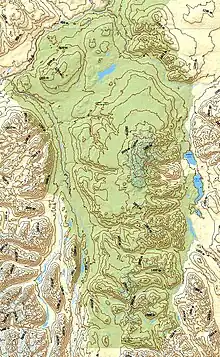
A three-month period of earthquake monitoring was conducted at the MEVC in 1968 after geologists of the Geological Survey of Canada suggested that there may still be magma movement under the volcanic complex. About 20 microearthquakes potentially associated with the MEVC were recorded by seismographs installed at Buckley Lake and Nuttlude Lake. They had magnitudes of around 0.5 which typically occur in many areas throughout the Canadian Cordillera.[107]
By 1970, Souther and his assistant Maurice Lambert had established that episodic eruptions of alkali basalt and silicic peralkaline lavas had taken place at the MEVC over a timespan of at least 10 million years. They had also established that volcanism at the MEVC was accompanied by east–west extension and incipient rifting of Earth's crust.[105] During his last year of serious field work in 1992, Souther published an extensive bulletin on his work entitled The Late Cenozoic Mount Edziza Volcanic Complex, British Columbia which highlighted the importance and size of the MEVC.[10][105] The volcanic complex has since received very few geological studies.[75][108]
A three-year period of field studies conducted at the MEVC around 2007 focused on using volcano-ice interactions to constrain paleo-environmental conditions. The project was a collaboration between Ben Edwards of Dickinson College, Ian Skilling of the University of Pittsburgh, Barry Cameron of the University of Wisconsin–Milwaukee, Ian Spooner of Acadia University, J. Osborn of the University of Calgary, Kirstie Simpson of the Geological Survey of Canada and Bill McIntosh of the New Mexico Institute of Mining and Technology.[109]
Five students conducted studies at the MEVC in 2007. Among them were Chira Endress of Dickinson Collage who examined sediment under a trachytic lava flow of the Ice Peak Formation, Jeff Hungerford of the University of Pittsburgh who carried out fieldwork around Tennena Cone, Courtney Haynes of Dickinson Collage who examined the geometry of pillow lavas, Alex Floyd of Dickinson Collage who performed a detailed examination of pillow lavas possibly derived from Pillow Ridge, and Kristen LaMoreaux of the University of Pittsburgh who examined Ornostay Bluff, Triangle Dome and lava flows from Koosick Bluff.[109]
Mineral exploration
A block of mineral claims called the Spectrum or Red Dog property existed in the former Mount Edziza Recreation Area just southeast of Mount Edziza throughout the latter half of the 20th century.[3][110] It covered quartz, pyrite and chalcopyrite mineralization in fractured sedimentary and volcanic rocks of Late Triassic age. Commodities on the property included copper, gold, lead, silver and zinc.[110] Mineral exploration on the Spectrum property began in at least 1957 when Torbit Silver Mines performed surface work on the gold-bearing Hawk vein. This was followed by drilling of the Hawk vein by Shawnigan Mining and Smelting in 1967. Exploration by Mitsui Mining and Smelting in 1970 involved geophysical and geochemical surveying. From 1971 to 1973, Imperial Oil conducted geophysical, geological and geochemical surveying, as well as 463 metres (1,519 feet) of drilling in four holes.[3]
Geochemical and geological surveys were conducted on the Spectrum property by Consolidated Silver Ridge Mines and Newhawk Mines between 1976 and 1981. Consolidated Silver Ridge Mines also built an airstrip and carried out 3,232 metres (10,604 feet) of drilling in 28 holes during this time period. Additional work on the Spectrum property by Newhawk Mines during this time period included the construction of an access road and 313 metres (1,027 feet) of underground development on the Hawk vein. Further geochemical and geological surveying was performed by Moongold Resources from 1987 to 1989. Mineral exploration conducted by Columbia Gold Mines from 1990 to 1992 consisted of rock sampling, trenching and 7,066 metres (23,182 feet) of drilling in 50 holes.[3]
Protected areas
Much of the MEVC was designated as a provincial park in 1972 to showcase its many geological and geothermal features.[6][47] A 101,171-hectare (250,000-acre) recreation area surrounding the 132,000-hectare (330,000-acre) park was also established in 1972.[111][112] In 1989, Mount Edziza Provincial Park roughly doubled in size when 96,770 hectares (239,100 acres) was annexed from the Mount Edziza Recreation Area.[112] In doing so, the recreation area was reduced in size to around 4,000 hectares (9,900 acres) and was eventually abolished in 2003.[111] Mount Edziza Provincial Park now covers an area of 266,180 hectares (657,700 acres), making it one of the largest provincial parks in British Columbia.[6][113]
In 2021, an approximately 3,528-hectare (8,720-acre) conservation area called the Mount Edziza Conservancy was established northwest of Kakiddi Lake along the eastern border of Mount Edziza Provincial Park.[114] It was established in collaboration with Skeena Resources, BC Parks, the Tahltan Central Government and the Nature Conservancy of Canada after Skeena Resources returned their mineral tenures on the Spectrum property.[115] The name of this conservation area was changed to the Tenh Dẕetle Conservancy in 2022 to better reflect the culture, history and tradition of the Tahltan First Nation.[114][116]
Recreation
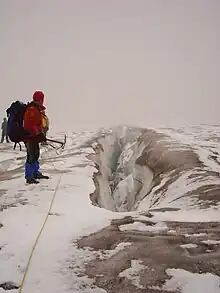
The MEVC offers many recreational activities, including mountain climbing, camping, fishing, hunting, horseback riding, wildlife viewing, photography, hiking and backpacking. Buckley Lake and Mowdade Lake on the northern and eastern sides of the MEVC contain campsites with fire rings, bear-proof metal food caches and backcountry-style toilets. It is advised by BC Parks to not gather wood for campfires within Mount Edziza Provincial Park to help maintain a healthy ecosystem community. The optimum time for backpacking is generally between July 1 and September 15 when weather conditions are the most suitable.[6]
Kakiddi Lake, Mowchilla Lake, Mowdade Lake, Nuttlude Lake and Buckley Lake are well populated with rainbow trout and offer fishing at the MEVC. A limited entry hunting authorization is required for the hunting of mountain goats, mountain sheep and caribou within Mount Edziza Provincial Park. Horseback riding at the MEVC requires a letter of authorization. The many cinder cones dotting the MEVC have designated climbing routes to prevent scarring on their delicate surfaces from foot traffic.[6]
A hiking trail dubbed the Buckley Lake to Mowdade Lake Route extends across the northern half of the MEVC.[16][117] It traverses south from Buckley Lake along Buckley Creek and gradually climbs onto the MEVC plateau where landmarks such as Eve Cone, Sidas Cone and Tsekone Ridge are visible along the route. Most of the Buckley Lake to Mowdade Lake Route is marked by a series of rock cairns from Tsekone Ridge onwards.[117]
The distance between Buckley Lake and Mowdade Lake is about 70 kilometres (43 miles) but the hiking length between these two lakes varies depending on the route taken. It can take a minimum of 7 days to hike the Buckley Lake to Mowdade Lake Route. The weather and climate can change extremely fast along this hiking trail.[117]
Accessibility
The MEVC lies in a remote location with no established road access.[10] The closest roads to the MEVC are the Stewart–Cassiar Highway to the east and the Telegraph Creek Road to the northwest, both of which extend within 40 kilometres (25 miles) of the volcanic complex.[1][16] Extending from these roads are horse trails that provide access to the MEVC.[10] From Telegraph Creek, the Buckley Lake Trail extends about 15 kilometres (9.3 miles) southeast along Mess Creek and Three Mile Lake. It then traverses about 15 kilometres (9.3 miles) northeast along Dagaichess Creek and Stinking Lake to the northeastern end of Buckley Lake where it meets with the Klastline River Trail and the Buckley Lake to Mowdade Lake Route.[16]
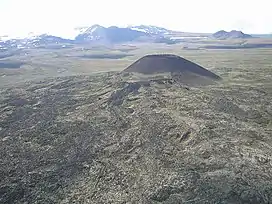
To the east, the roughly 50-kilometre-long (31-mile) Klastline River Trail begins at the community of Iskut on the Stewart–Cassiar Highway. It extends northwest and west along the Klastline River for much its length. The trail enters Mount Edziza Provincial Park at about 25 kilometres (16 miles) where Kakiddi Creek drains into the Klastline River. After entering Mount Edziza Provincial Park, the Klastline River Trail traverses northwest along the Klastline River for about 10 kilometres (6.2 miles) and then crosses the river north of the MEVC. From there, the Klastline River Trail traverses west for about 15 kilometres (9.3 miles) to the northeastern end of Buckley Lake where it meets with the Buckley Lake Trail and Buckley Lake to Mowdade Lake Route junction.[16]
From near the Eastman Creek Rest Area south of Kinaskan Lake on the Stewart–Cassiar Highway, the historic Yukon Telegraph Trail extends about 15 kilometres (9.3 miles) west to the Little Iskut River. From there, it enters Mount Edziza Provincial Park and continues another 15 kilometres (9.3 miles) west along Bourgeaux Creek into the central portion of the MEVC at Raspberry Pass. The Yukon Telegraph Trail then traverses about 10 kilometres (6.2 miles) northwest along Raspberry Creek into the broad valley of Mess Creek where it continues another 30 kilometres (19 miles) north along the western side of the MEVC. It conjoins with the Buckley Lake Trail near Matheson Creek.[16] Only short segments of the Yukon Telegraph Trail are still passible, having been mostly overgrown since maintenance of the trail ended in 1936.[10]
The MEVC can also be accessed by float plane or helicopter, both of which are available for charter at the communities of Iskut and Dease Lake.[10] Private aircraft are prohibited from landing on the Kitsu Plateau lava flows.[6] Kakiddi Lake, 180 Lake, Mess Lake, Arctic Lake, Nuttlude Lake, Mowdade Lake, Little Arctic Lake, Little Ball Lake, Mowchilla Lake and Buckley Lake are large enough to be used by float-equipped aircraft.[6][10] Landing on the latter four lakes with a private aircraft requires a letter of authorization from the BC Parks Stikine Senior Park Ranger.[6]
See also
Notes
- Mafic pertains to magmatic rocks that are relatively rich in iron and magnesium, relative to silicium.[54]
- Felsic pertains to magmatic rocks that are enriched in silicon, oxygen, aluminum, sodium and potassium.[54]
- A strike-slip fault features two blocks of the Earth's crust moving past each other horizontally in opposite directions.[60]
- Peralkaline rocks are magmatic rocks that have a higher ratio of sodium and potassium to aluminum.[64]
- A dike is a sheet-shaped intrusion of magma into pre-existing rock.[82]
- Volcaniclastic rocks are broken fragments (clasts) of volcanic rock.[64]
References
- Wood, Charles A.; Kienle, Jürgen (2001). Volcanoes of North America: United States and Canada. Cambridge University Press. pp. 124, 125. ISBN 0-521-43811-X.
- "Mount Edziza". BC Geographical Names. Archived from the original on 2018-05-15. Retrieved 2021-09-25.
- Wojdak, Paul (1993). Evaluation of Mineral Potential for Mount Edziza Recreation Area (PDF) (Report). Government of British Columbia. pp. 1, 3. Archived from the original (PDF) on 2021-09-30. Retrieved 2023-05-03.
- Edwards, Benjamin R.; Russell, James K. (2000). "Distribution, nature, and origin of Neogene–Quaternary magmatism in the northern Cordilleran volcanic province, Canada". Geological Society of America Bulletin. Geological Society of America. 112 (8): 1280–1284, 1286–1287, 1291–1293. doi:10.1130/0016-7606(2000)112<1280:dnaoon>2.0.co;2. ISSN 0016-7606.
- Yagi, Kenzo; Souther, Jack Gordon (1974). "Aenigmatite From Mt. Edziza, British Columbia, Canada" (PDF). American Mineralogist. Mineralogical Society of America. 59: 820. Archived from the original (PDF) on 2021-04-01. Retrieved 2021-09-27.
- "Mount Edziza Provincial Park". BC Parks. Archived from the original on 2023-01-23. Retrieved 2021-10-21.
- Telegraph Creek, Cassiar Land District, British Columbia (Topographic map) (3 ed.). 1:250,000. A502 (in English and French). Department of Energy, Mines and Resources. 1989. Archived from the original on 2021-05-02. Retrieved 2021-09-25.
- "Pillow Ridge". BC Geographical Names. Archived from the original on 2016-03-04. Retrieved 2021-09-26.
- "Spectrum Range". BC Geographical Names. Archived from the original on 2020-06-30. Retrieved 2021-09-26.
- Souther, J. G. (1992). The Late Cenozoic Mount Edziza Volcanic Complex, British Columbia. Geological Survey of Canada. pp. 1–9, 11–28, 31–33, 35, 36, 41, 44, 47, 61, 71, 76, 83, 93, 100, 101, 104, 108, 113, 119, 120, 122, 129, 131, 132, 150, 154, 155, 157, 175, 178, 181, 191, 199–201, 207, 213–219, 222, 224–226, 228, 231, 233–236, 241, 242, 248–250, 267, 320. doi:10.4095/133497. ISBN 0-660-14407-7.
- Souther, J. G.; Hickson, C. J. (1984). "Crystal fractionation of the basalt comendite series of the mount Edziza volcanic complex, British Columbia: Major and trace elements". Journal of Volcanology and Geothermal Research. Elsevier. 21 (1): 79. doi:10.1016/0377-0273(84)90017-9.
- "Spectrum Range: General Information". Global Volcanism Program. Smithsonian Institution. Archived from the original on 2022-09-22. Retrieved 2022-10-03.
- Demarchi, Dennis A. (2011). An Introduction to the Ecoregions of British Columbia. Government of British Columbia. pp. 140, 143–150, 153. OCLC 613357103.
- Holland, Stuart S. (1976). Landforms of British Columbia: A Physiographic Outline (PDF) (Report). Government of British Columbia. pp. 49, 50. ASIN B0006EB676. OCLC 601782234. Archived from the original (PDF) on 2018-11-14.
- "Arctic Lake". BC Geographical Names. Archived from the original on 2021-10-01. Retrieved 2021-09-26.
- Mussio, Russell, ed. (2018). Northern BC Backroad Mapbook. Mussio Ventures. pp. 88, 89, 96. ISBN 978-1-926806-87-7.
- "Little Ball Lake". BC Geographical Names. Retrieved 2023-04-29.
- "Little Arctic Lake". BC Geographical Names. Retrieved 2023-04-29.
- "Wetalth Ridge". Government of Canada. Retrieved 2023-04-29.
- "Mess Creek". BC Geographical Names. Archived from the original on 2021-08-20. Retrieved 2022-09-29.
- "Crayke Creek". BC Geographical Names. Archived from the original on 2021-10-01. Retrieved 2022-09-29.
- "Elwyn Creek". BC Geographical Names. Archived from the original on 2021-10-01. Retrieved 2022-09-29.
- "Kitsu Creek". Government of Canada. Retrieved 2023-04-24.
- "Kitsu Creek". BC Geographical Names. Archived from the original on 2021-10-01. Retrieved 2022-04-24.
- "Raspberry Creek". BC Geographical Names. Archived from the original on 2021-08-20. Retrieved 2022-09-29.
- "Tadekho Creek". BC Geographical Names. Archived from the original on 2021-09-30. Retrieved 2022-09-29.
- "Taweh Creek". BC Geographical Names. Archived from the original on 2021-10-01. Retrieved 2022-09-29.
- "Nagha Creek". BC Geographical Names. Archived from the original on 2021-10-01. Retrieved 2023-04-24.
- "Walkout Creek". BC Geographical Names. Archived from the original on 2020-10-31. Retrieved 2023-04-24.
- "Flyin Creek". BC Geographical Names. Archived from the original on 2021-10-01. Retrieved 2023-04-24.
- "Sezill Creek". BC Geographical Names. Archived from the original on 2021-10-01. Retrieved 2023-04-24.
- "Nido Creek". BC Geographical Names. Archived from the original on 2021-10-01. Retrieved 2022-09-29.
- "Tenchen Creek". BC Geographical Names. Archived from the original on 2021-10-01. Retrieved 2022-09-29.
- "Tennaya Creek". BC Geographical Names. Archived from the original on 2021-09-30. Retrieved 2022-09-29.
- "Shaman Creek". BC Geographical Names. Archived from the original on 2021-10-01. Retrieved 2022-09-29.
- "Sorcery Creek". BC Geographical Names. Archived from the original on 2021-10-01. Retrieved 2022-09-29.
- "Tsecha Creek". BC Geographical Names. Archived from the original on 2021-09-30. Retrieved 2022-09-29.
- "Chakima Creek". BC Geographical Names. Archived from the original on 2021-10-01. Retrieved 2023-05-01.
- "Ball Creek". BC Geographical Names. Archived from the original on 2021-10-24. Retrieved 2022-09-29.
- "More Creek". BC Geographical Names. Archived from the original on 2021-09-30. Retrieved 2022-09-29.
- "Little Iskut River". BC Geographical Names. Archived from the original on 2021-10-24. Retrieved 2022-09-29.
- "Chachani Creek". BC Geographical Names. Retrieved 2023-04-24.
- "Stewbomb Creek". BC Geographical Names. Archived from the original on 2021-10-01. Retrieved 2023-04-24.
- "Bourgeaux Creek". BC Geographical Names. Archived from the original on 2021-09-30. Retrieved 2023-04-24.
- "Artifact Creek". BC Geographical Names. Archived from the original on 2021-10-01. Retrieved 2023-04-24.
- "Gerlib Creek". BC Geographical Names. Archived from the original on 2021-10-01. Retrieved 2023-04-24.
- D.R. Piteau and Associates (1988). Geochemistry and Isotope Hydrogeology of the Mount Edziza and Mess Creek Geothermal Waters, British Columbia (Report). Open File 1732. Geological Survey of Canada. pp. 1, 3, 4. Retrieved 2023-05-03.
- "Idiji Glacier". BC Geographical Names. Retrieved 2022-09-29.
- "Nagha Glacier". BC Geographical Names. Retrieved 2023-04-19.
- "Tenchen Glacier". BC Geographical Names. Retrieved 2022-09-29.
- "Tencho Glacier". BC Geographical Names. Retrieved 2022-09-29.
- "Tennaya Glacier". BC Geographical Names. Retrieved 2022-09-29.
- "Map of Canadian volcanoes". Volcanoes of Canada. Natural Resources Canada. 2008-02-13. Archived from the original on 2008-06-02.
- Pinti, Daniele (2011), "Mafic and Felsic", Encyclopedia of Astrobiology, Springer Berlin Heidelberg, p. 938, doi:10.1007/978-3-642-11274-4_1893, ISBN 978-3-642-11271-3
- Edwards, Benjamin Ralph (1997). "1". Field, Kinetic, and Thermodynamic Studies of Magmatic Assimilation in the Northern Cordilleran Volcanic Province, Northwestern British Columbia (PhD). University of British Columbia. p. 6. doi:10.14288/1.0052728.
- "Level Mountain". Global Volcanism Program. Smithsonian Institution. Archived from the original on 2021-08-17. Retrieved 2021-10-19.
- "Heart Peaks". Global Volcanism Program. Smithsonian Institution. Archived from the original on 2021-05-02. Retrieved 2021-10-19.
- "Hoodoo Mountain". Global Volcanism Program. Smithsonian Institution. Archived from the original on 2021-10-19. Retrieved 2021-08-17.
- "Catalogue of Canadian volcanoes". Stikine volcanic belt. Natural Resources Canada. 2008-02-13. Archived from the original on 2008-06-15. Retrieved 2021-10-19.
- Massironi, Matteo; Kim, Young-Seog (2021). "Strike-Slip Faults". Encyclopedia of Planetary Landforms. Springer Science+Business Media: 1–12. doi:10.1007/978-1-4614-9213-9_548-1. ISBN 978-1-4614-9213-9.
- Lakeman, Thomas R.; Clague, John J.; Menounos, Brian; Osborn, Gerald D.; Jensen, Britta J. L.; Froese, Duane G. (2008). "Holocene tephras in lake cores from northern British Columbia, Canada". Canadian Journal of Earth Sciences. NRC Research Press. 45 (8): 940. doi:10.1139/E08-035. ISSN 1480-3313.
- Edwards, B. R. (2010). Hazards associated with alkaline glaciovolcanism at Hoodoo Mountain and Mt. Edziza, western Canada: comparisons to the 2010 Eyjafjallajokull eruption. American Geophysical Union, Fall Meeting 2010. Astrophysics Data System. Bibcode:2010AGUFMNH11B1132E.
- Souther, Jack Gordon (1966). "Cordilleran Volcanic Study, 1966". Report of Activities, Part A: May to October, 1966 (PDF) (Report). Geological Survey of Canada. pp. 89, 91. Archived from the original (PDF) on 2023-01-07. Retrieved 2023-05-15.
- Imam, Naiyar (2003). Dictionary of Geology and Mineralogy. McGraw–Hill Companies. pp. 253, 390. ISBN 0-07-141044-9.
- Souther, J. G.; Symons, D. T. A. (1974). Stratigraphy and Paleomagnetism of Mount Edziza Volcanic Complex, Northwestern British Columbia (PDF) (Report). Geological Survey of Canada. Retrieved 2023-05-18.
- "Kitsu Plateau". BC Geographical Names. Retrieved 2023-04-18.
- "Destell Pass". BC Geographical Names. Archived from the original on 2021-10-19. Retrieved 2023-04-17.
- "Raspberry Pass". BC Geographical Names. Archived from the original on 2021-10-19. Retrieved 2023-04-17.
- "Ornostay Bluff". BC Geographical Names. Archived from the original on 2021-10-01. Retrieved 2023-04-19.
- "Koosick Bluff". BC Geographical Names. Archived from the original on 2021-09-30. Retrieved 2023-04-19.
- "Hoia Bluff". BC Geographical Names. Retrieved 2023-04-19.
- "Kaia Bluff". BC Geographical Names. Archived from the original on 2021-09-30. Retrieved 2023-04-19.
- "Gnu Butte". BC Geographical Names. Archived from the original on 2021-10-01. Retrieved 2023-04-19.
- "Mess Lake Escarpment". BC Geographical Names. Archived from the original on 2021-10-01. Retrieved 2023-04-19.
- Wilson, Alexander M.; Kelman, Melanie C. (2021). Assessing the relative threats from Canadian volcanoes (Report). Open File 8790. Natural Resources Canada. pp. 16, 33, 34, 40. doi:10.4095/328950.
- Souther, J. G. "Geothermal Power, The Canadian Potential". Geoscience Canada. Geological Association of Canada. 3 (1): 17. ISSN 0315-0941.
- Lamoreaux, K. A.; Skilling, I. P.; Endress, C.; Edwards, B.; Lloyd, A.; Hungerford, J. (2006). Preliminary Studies of the Emplacement of Trachytic Lava Flows and Domes in an Ice- Contact Environment: Mount Edziza, British Columbia, Canada. American Geophysical Union, Fall Meeting 2006. Astrophysics Data System. Bibcode:2006AGUFM.V53C1757L.
- White, J. D. L.; Riggs, N. R., eds. (2001). "Eruptions and eruption-formed lakes". Volcaniclastic Sedimentation in Lacustrine Settings. Blackwell Science. pp. 13, 14. ISBN 0-632-05847-1.
- Kleemann, Katrin (2023). "Icelandic Volcanism in the Holocene". A Mist Connection: An Environmental History of the Laki Eruption of 1783 and Its Legacy. Vol. 30. De Gruyter. ISBN 978-3-11-073717-2.
- Smellie, John L.; Edwards, Benjamin R. (2016). Glaciovolcanism on Earth and Mars: Products, Processes and Palaeoenvironmental Significance. Cambridge University Press. pp. 42–44. ISBN 978-1-107-03739-7.
- "Raspberry Formation". Lexicon of Canadian Geologic Units. Government of Canada. Archived from the original on 2023-08-05. Retrieved 2023-08-04.
- Korteniemi, Jarmo (2015). "Dike (Igneous)". Encyclopedia of Planetary Landforms. Springer Science+Business Media. pp. 591–595. doi:10.1007/978-1-4614-3134-3_112. ISBN 978-1-4614-3134-3.
- "Little Iskut Formation". Lexicon of Canadian Geologic Units. Government of Canada. Archived from the original on 2023-08-05. Retrieved 2023-08-04.
- "Nido Formation". Lexicon of Canadian Geologic Units. Government of Canada. Archived from the original on 2023-08-05. Retrieved 2023-08-13.
- "Cartoona Peak". BC Geographical Names. Archived from the original on 2021-09-30. Retrieved 2021-10-03.
- "Edziza: General Information". Global Volcanism Program. Smithsonian Institution. Archived from the original on 2021-08-10. Retrieved 2021-09-25.
- "Edziza: Eruptive History". Global Volcanism Program. Smithsonian Institution. Archived from the original on 2023-05-20. Retrieved 2023-06-01.
- Souther, J. G. (1981). Volcanic hazards in the Stikine region of northwestern British Columbia (Report). Open File 770. Geological Survey of Canada. p. 1. Retrieved 2023-06-20.
- "Stikine volcanic belt: Mount Edziza". Catalogue of Canadian volcanoes. Natural Resources Canada. 2009-04-01. Archived from the original on 2009-06-08. Retrieved 2009-03-30.
- Fairbank, B. D.; Faulkner, R. L. (1992). Geothermal Resources of British Columbia (Map). 1:2,000,000. Open File 2526. Geological Survey of Canada. doi:10.4095/133397.
- Souther, Jack (1980). "Projected Geothermal Energy Development in Canada". Proceedings of the Fourth Annual Geothermal Conference and Workshop (Report). Electric Power Research Institute. p. 7-53. Retrieved 2023-08-03.
- "Spectrum Range: Synonyms & Subfeatures". Global Volcanism Program. Smithsonian Institution. Archived from the original on 2022-09-22. Retrieved 2022-10-03.
- "Edziza: Synonyms & Subfeatures". Global Volcanism Program. Smithsonian Institution. Archived from the original on 2021-08-10. Retrieved 2021-10-03.
- "Eruption column". United States Geological Survey. 2015-07-28. Archived from the original on 2023-03-15. Retrieved 2023-05-19.
- "Monitoring volcanoes". Volcanoes of Canada. Natural Resources Canada. 2009-02-26. Archived from the original on June 8, 2008. Retrieved 2022-04-09.
- "Interagency Volcanic Event Notification Plan (IVENP)". Volcanoes of Canada. Natural Resources Canada. 2008-06-04. Archived from the original on February 14, 2009. Retrieved 2022-04-09.
- Markey, Sean; Halseth, Greg; Manson, Don (2012). Investing in Place: Economic Renewal in Northern British Columbia. University of British Columbia Press. p. 242. ISBN 978-0-7748-2293-0.
- "Archaeological Overview Assessment of the Cassiar-Iskut-Stikine LRMP" (PDF). Government of British Columbia. 1998. pp. 44, 46. Archived from the original (PDF) on 2022-07-05. Retrieved 2023-05-02.
- "Tahltan land to be protected in partnership with conservation organizations, industry and Province". Government of British Columbia. 2021. Archived from the original on 2022-11-18. Retrieved 2023-05-03.
- "Yukon Telegraph Trail". Canadian Register of Historic Places. Retrieved 2023-05-01.
- Miller, Bill (2004). "The Early Years: Discontent and Description". Wires in the Wilderness: The Story of the Yukon Telegraph. Heritage House Publishing. p. 133. ISBN 978-1-894384-58-2.
- Souther, Jack G. (1976). "Geothermal Potential of Western Canada". Proceedings: Second United Nations Symposium on the Development and Use of Geothermal Resources. Vol. 1. Energy Research and Development Administration. p. 261.
- VandenBygaart, A. J. (2011). "Regosolic soils of Canada: Genesis, distribution and classification". Canadian Journal of Soil Science. Canadian Science Publishing. 91 (5): 882. doi:10.4141/CJSS10021.
- "Stikinia Terrane, Canadian Cordillera" (PDF). United States Geological Survey. Archived from the original (PDF) on 2017-03-09. Retrieved 2022-06-29.
- "Acceptance of the 1995 Career Achievement Award by Jack Souther" (PDF). Ash Fall. Geological Association of Canada. 1996. p. 3. Archived from the original (PDF) on 2018-12-05.
- Brown, Derek A.; Gunning, Michael H.; Greig, Charles J. (1996). The Stikine Project: geology of western Telegraph Creek map area, northwestern British Columbia. British Columbia Geological Survey. p. 4. ISBN 0-7726-2502-6.
- Milne, W. G.; Smith, W. E. T.; Rogers, G. C. (1970). "Canadian seismicity and microearthquake research in Canada". Canadian Journal of Earth Sciences. National Research Council Canada. 7 (2): 598, 599. doi:10.1139/e70-060.
- Hickson, Catherine; Mulder, Taimi (2003). "The Vulnerability of Canada to Volcanic Hazards". Natural Hazards. Kluwer Academic Publishers. 28 (2/3): 564. doi:10.1023/A:1022954829974. S2CID 129461798.
- "Fieldwork at Mount Edziza" (PDF). Ash Fall. Geological Association of Canada. 2007. pp. 5, 6. Archived from the original (PDF) on 2018-12-05.
- "MINFILE No. 104B 036". Ministry of Energy, Mines and Petroleum Resources. Archived from the original on 2013-05-15. Retrieved 2021-05-14.
- "Mount Edziza Recreation Area". BC Geographical Names. Retrieved 2023-05-03.
- "Mount Edziza Park". BC Geographical Names. Archived from the original on 2018-07-06. Retrieved 2023-05-03.
- "Edziza: Photo Gallery". Global Volcanism Program. Smithsonian Institution. Archived from the original on 2021-09-21. Retrieved 2023-05-03.
- "Tenh Dẕetle Conservancy". BC Geographical Names. Retrieved 2023-05-04.
- "Condensed Interim Consolidated Financial Statements" (PDF). p. 13. Archived from the original (PDF) on 2022-05-16. Retrieved 2022-05-05.
- "Conservancy renamed Ice Mountain, reflects Tahltan heritage". Government of British Columbia. 9 February 2022. Archived from the original on 2022-09-27. Retrieved 2023-04-30.
- "Mount Edziza Provincial Park". BC Parks. Archived from the original on 2022-06-26. Retrieved 2023-04-29.
External links
- "Mt. Edziza, NW British Columbia, Canada". Oregon State University. 2000. Archived from the original on 2009-04-11.
- LaMoreaux, Kristen A. (2008). Recognizing Ice-Contact Trachyte-Phonolite Lavas at the Mount Edziza Volcanic Complex, British Columbia, Canada (PDF) (M.S.). University of Pittsburgh. Archived from the original (PDF) on 2022-09-29.